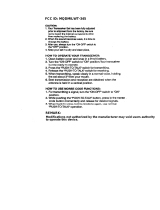
PROGRAM SCAN PARTIALLY SLOWED........ 47
SCAN HOLD ..................................................... 48
MEMORY SCAN ................................................... 48
SCAN RESUME ................................................ 48
ALL-CHANNEL SCAN....................................... 48
GROUP SCAN .................................................. 49
Memory Group ............................................. 49
Scan Group Select ....................................... 49
Performing Group Scan................................ 49
QUICK MEMORY SCAN....................................... 49
CHAPTER 12 OPERATOR CONVENIENCES
ANTENNAS........................................................... 50
ANT 1/ ANT 2 .................................................... 50
RX ANT ............................................................. 50
DRV................................................................... 50
APO (Auto Power OFF)......................................... 50
AUTOMATIC ANTENNA TUNER.......................... 50
PRESETTING ................................................... 51
AUTO MODE......................................................... 51
BEEP FUNCTION ................................................. 52
DISPLAY ............................................................... 53
BRIGHTNESS ................................................... 53
BACKLIGHT COLOR ........................................ 53
PANEL KEY DOUBLE FUNCTION RESPONSE
TIME...................................................................... 53
LINEAR AMPLIFIER CONTROL........................... 53
LOCK FUNCTIONS............................................... 53
FREQUENCY LOCK FUNCTION ..................... 53
PROGRAMMABLE FUNCTION KEYS.................. 54
TRANSCEIVER FRONT PANEL....................... 54
MICROPHONE KEYS ....................................... 54
DSP RX EQUALIZER............................................ 55
Equalizing Receiving Audio.......................... 55
RX MONITOR ................................................... 55
TIME-OUT TIMER................................................. 55
TRANSVERTER.................................................... 55
FREQUENCY DISPLAY.................................... 55
TRANSMISSION OUTPUT POWER................. 56
TX MONITOR........................................................ 56
TX POWER ........................................................... 56
TX TUNE ............................................................... 56
QUICK DATA TRANSFER .................................... 56
SETTING UP..................................................... 56
Equipment Needed....................................... 56
Connections ................................................. 56
USING QUICK TRANSFER .............................. 57
Transferring Data ......................................... 57
Receiving Data............................................. 57
COMPUTER CONTROL ....................................... 57
SETTING UP..................................................... 57
Equipment Needed....................................... 57
Connections ................................................. 57
COMMUNICATION PARAMETERS ................. 57
EXTERNAL AUDIO SETTINGS ........................ 58
Selecting a Data Transmission Line............. 58
Audio Level Settings..................................... 58
TERMINAL ........................................................ 58
CONTROLLING THE TS-590S FROM A PC .... 58
REMOTELY CONTROLLING THE TS-590S ON
THE NETWORK................................................ 58
OPTIONAL VGS-1 VOICE GUIDE & STORAGE
UNIT ...................................................................... 58
Transmitting CW Messages ......................... 35
Changing the Inter-message Interval Time
... 35
Changing the CW Sidetone Volume............. 35
Insert Keying ................................................ 35
FREQUENCY CORRECTION FOR CW ........... 35
AUTO CW TX IN SSB MODE ........................... 36
MIC UP/ DWN KEY PADDLE MODE................ 36
SWAP DOT AND DASH PADDLE POSITIONS 36
CHAPTER 8 DATA COMMUNICATIONS
RADIO TELETYPE (RTTY)................................... 37
PHASE-SHIFT KEYING 31 BAUD (PSK31).......... 37
CHAPTER 9 REJECTING INTERFERENCE
DSP FILTERS ....................................................... 38
CHANGING THE DSP FILTER BANDWIDTH .. 38
SSB/ FM/ AM Mode...................................... 38
CW/ FSK Mode ............................................ 38
Data Mode.................................................... 38
IF Filter A and B ........................................... 38
AUTO NOTCH FILTER (SSB)............................... 39
AUTO NOTCH TRACKING SPEED.................. 39
MANUAL NOTCH FILTER (SSB/ CW/ FSK)......... 39
Notch Filter Bandwidth ................................. 39
BEAT CANCEL (SSB/ AM) ............................... 39
NOISE REDUCTION (ALL MODES)................. 39
Setting the NR1 Level Adjustment ............... 40
Setting the NR2 Time Constant.................... 40
NOISE BLANKER ................................................. 40
PRE-AMPLIFIER................................................... 40
ATTENUATOR ...................................................... 40
CW REVERSE (RECEPTION).............................. 40
CHAPTER 10 MEMORY FEATURES
MEMORY CHANNELS.......................................... 41
STORING DATA IN MEMORY.......................... 41
Simplex Channels ........................................ 41
Split-Frequency Channels............................ 41
MEMORY RECALL AND SCROLL ................... 42
Memory Recall ............................................. 42
Memory Scroll .............................................. 42
Temporary Frequency Changes................... 42
MEMORY TRANSFER...................................... 42
Memory °VFO Transfer.............................. 42
Channel ° Channel Transfer ....................... 42
STORING FREQUENCY RANGES .................. 43
Confirming Start/ End Frequencies .............. 44
Programmable VFO ..................................... 44
MEMORY CHANNEL LOCKOUT...................... 44
ERASING MEMORY CHANNELS .................... 44
MEMORY CHANNEL NAME............................. 44
QUICK MEMORY.................................................. 44
NUMBER OF QUICK MEMORY CHANNELS... 45
STORING INTO QUICK MEMORY................... 45
RECALLING QUICK MEMORY CHANNELS.... 45
TEMPORARY FREQUENCY CHANGES ......... 45
QUICK MEMORY ° VFO TRANSFER ............. 45
ERASING QUICK MEMORY CHANNELS ........ 45
CHAPTER 11 SCAN
NORMAL SCAN .................................................... 46
VFO SCAN ........................................................ 46
PROGRAM SCAN............................................. 46





















